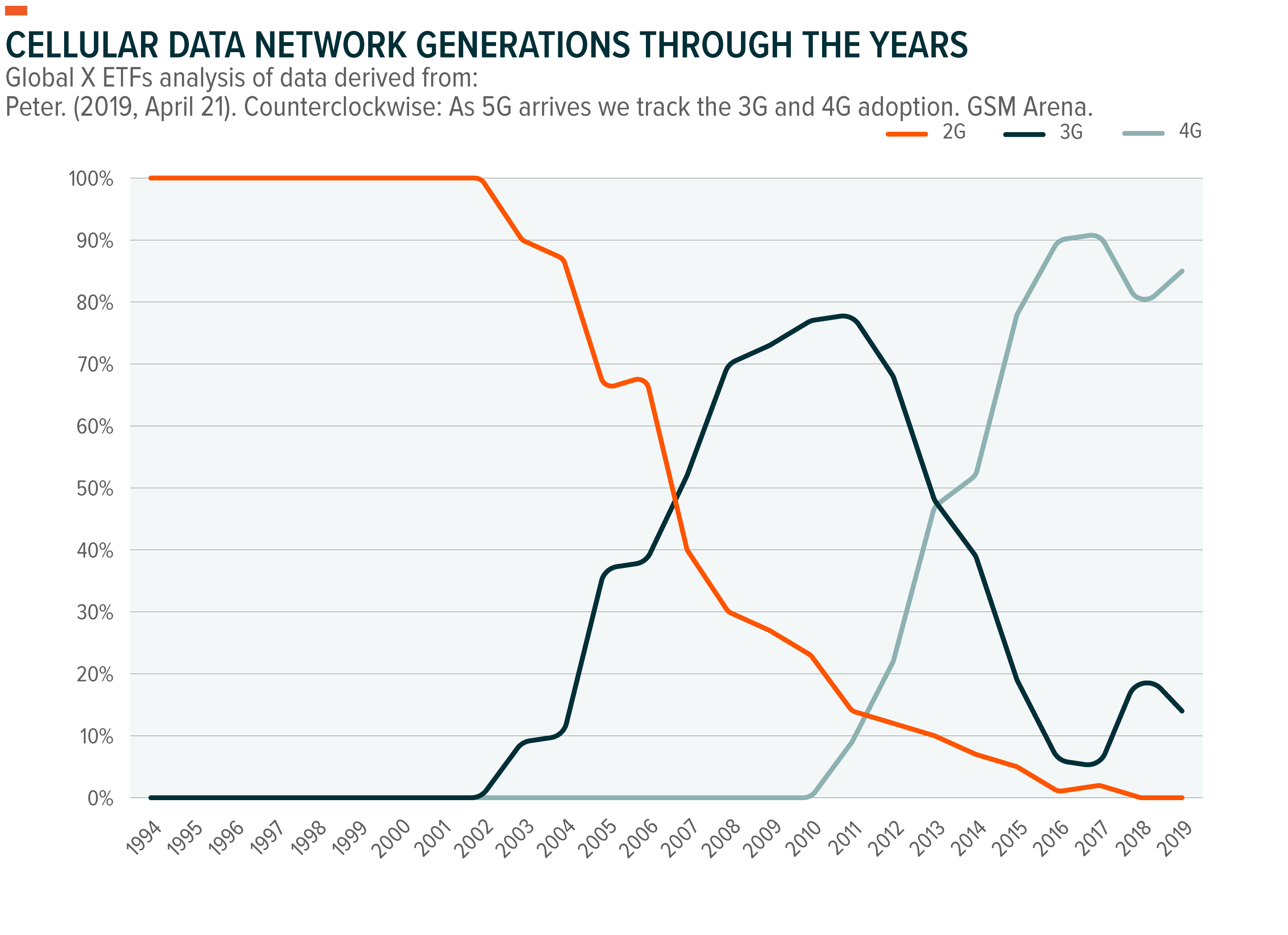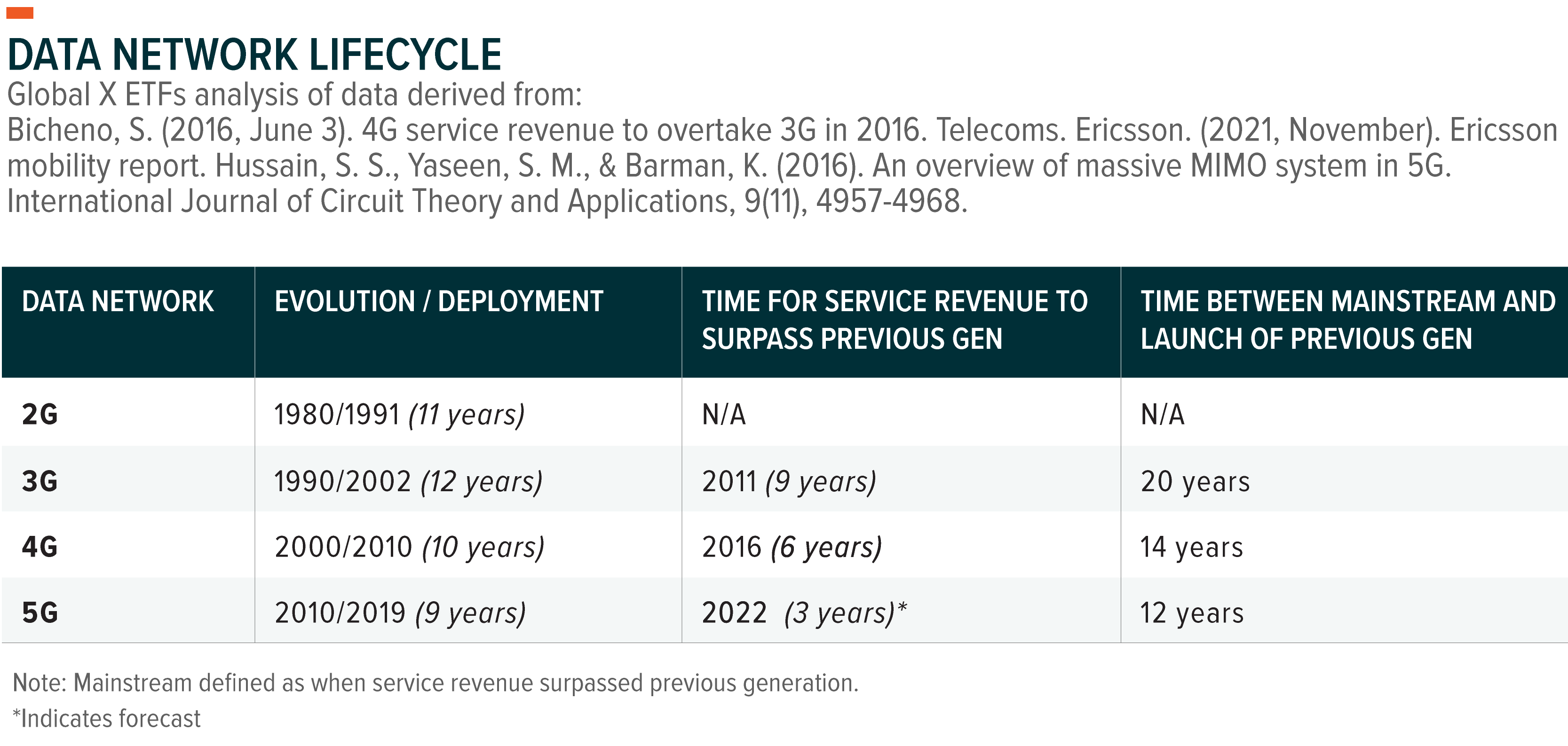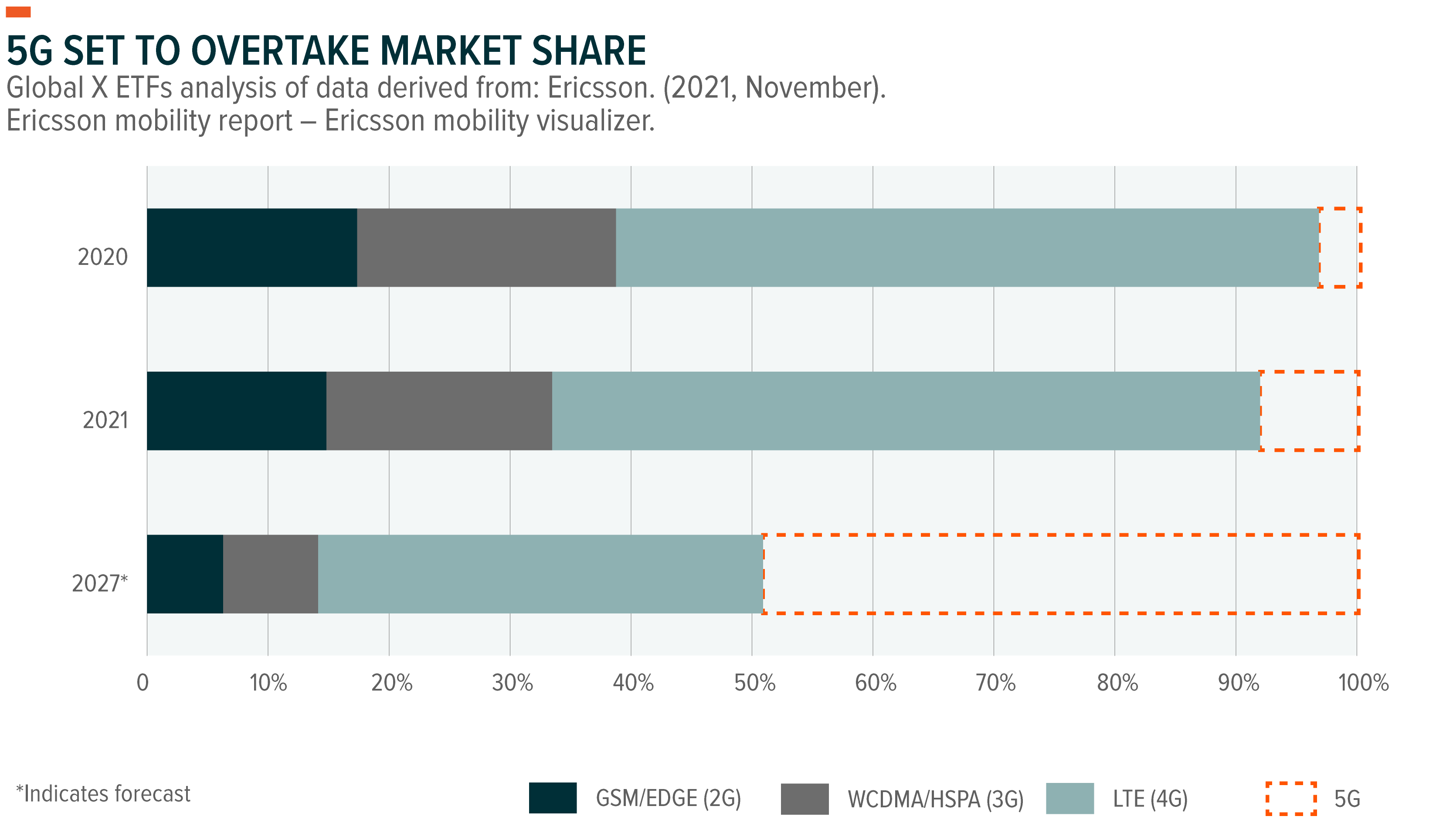The transition from landline phones to the mobility that 1G wireless technology offered was a massive leap. But in our view, the leap from 4G to 5G is just as big, as 5G is the vessel that will expand the Internet of Things (IoT) ecosystem exponentially. We expect the growing number of connected devices communicating at higher multi-gigabit data speeds and investments to increase network capacity to expedite 5G’s adoption rate. And as individual and corporate consumers experience 5G’s benefits, they will set the stage for 6G’s proliferation—which history suggests is likely to come sooner than later.
Key Takeaways
- Broadband IoT, comprising 4G and 5G wireless technologies, is on pace to overtake 2G and 3G as the segment that enables the largest share of IoT applications globally by 2027.
- The number of connected IoT devices worldwide increased by about 9% in 2021 to 12.3 billion active endpoints. And that number is expected to more than double to over 27 billion as soon as 2025.1
- The momentum for 5G continues to increase with companies already implementing the technology. 5G is expected to make 4G obsolete by 2030, by which point 6G could be ready to transform IoT yet again.
5G Network Expected to Achieve Widespread in 2025
As with all new networks, mass adoption of 5G will take time, but not as much time as its predecessors. 3G adoption wasn’t immediate, due to consumer hesitation towards change as well as 3G’s higher price points. The easiest way to draw a parallel to data network evolution involves taking a look at the pace at which previous cellular networks developed. Launched in 2001, 3G cellular networks did not become the norm until 2007, when consumers embraced 3G-connected phones—four years after 3G became widely available and 16 years after 2G mobile connectivity became available.2 Comparatively, 4G cellular networks were deployed in 2009 and became the norm four years later in 2013—two years faster than the 2G to 3G transition and only 12 years after 3G launched.3,4

In line with these historical trends, we expect 5G’s adoption rate to follow in the footsteps of 4G’s rapid move to mainstream. After small-scale deployment in 2015, as enterprises began testing 5G technology, current estimates suggest global widespread adoption of 5G occurs in 2025.5 4G mobile subscriptions are projected to peak at 4.7 billion in Q4 2021, and then progressively decline to 3.3 billion by the end of 2027, as 5G becomes the primary subscription choice.6

Telecoms Report Momentum for 5G Adoption Evident Already
At its core, 5G is designed to enhance the IoT’s consumer experience. Consumers will be able to access cloud services ranging from multiplayer cloud gaming, augmented reality (AR)-powered shopping experiences, and access to autonomous drones for deliveries. As consumers experience 5G power, the more they’re likely to explore. And according to telecom providers, the word is getting out.
Verizon reported that 25% of its consumer wireless customers used 5G-capable devices less than 12 months after their release, well ahead of 4G’s 10% adoption rate 12 months after launch.7 As part of the 5G ramp-up, telecoms are shutting down older generations, including 3G, to repurpose frequencies and improve their 4G and 5G networks. AT&T phased out 3G connections in February 2022.8 T-Mobile plans to follow suit in July, and Verizon by the end of this year.9 By the end of 2027, 40% of cellular IoT connections are expected to be broadband IoT (4G/5G).10

5G’s Potential Increasingly on Display
Several notable IoT companies are early adopters of 5G technology. In some cases, 5G made their older models obsolete. In other cases, 5G spurred the development of new technologies.
One example is Qualcomm’s Snapdragon, the company’s mobile systems on a chip (SoC) product suite. In handsets, the Snapdragon 8 Gen 1 is the world’s first 5G modem-radio-frequency solution to reach a 10-gigabit download speed, or 10,000 megabits.11 At this speed, enormous data files can be downloaded in the blink of an eye. For context, 4K streaming across multiple devices requires only about 100 megabits, or 1% of Snapdragon 8 Gen 1’s full potential. Qualcomm estimates 5G-enabled handsets will reach 750 million units sold in 2022.12
Cisco’s Catalyst 900X switching platform is another example. Built on Cisco’s Silicon One technology, the 900X allows the company to use high-speed WiFi 6E access points to provide 5G and cloud-based solutions. It extends the life of existing cabling from 1 to 10 gigabits.13 Cisco intends to offer 5G as-a-service solutions widely available to private enterprises, the growth potential of which could be significant given the need for enhanced data speeds, cloud connectivity, and mobility in hybrid business models. Historically, enterprises reliant on security, such as the Federal Emergency Management Agency, and on connectivity, such as software-as-a-service provider, Zendesk, relied on Cisco’s switch technology. Cisco expects spending on private LTE and 5G network infrastructure by organizations to exceed $5.7 billion by 2024.14
Likewise, robotics company ABB partnered with networking and telecom company Ericsson to create the smart factories of the future. ABB plans to use 5G technology to automate customer service in utilities, industrial, transport, and infrastructure segments. 5G is expected to allow more factory robots to tap into the cloud for greater computing power and eliminate comparatively inefficient and costly in-house central processing units or graphics processing units. At the same time, robots can be controlled via 5G wireless connectivity within a distance of 1.5 kilometers and still exhibit real-time control, given 5G’s ultra-low latency capabilities.15 The global market for 5G in cloud robotics is expected to grow at a 79.2% compound annual growth rate to reach $10.6 billion by 2028.16
5G Adoption to Pave the Way for 6G
We expect structural tailwinds to result from 5G’s ability to connect virtually everyone and everything faster and more powerfully than ever. And 5G’s expedited adoption rate relative to its predecessors will prep the global economy for an even faster rollout of the next generation. 6G, which could hit the market by 2030, will offer greater use of distributed radio access network (RAN), terahertz (THz) spectrum for even more capacity, lower latency, and better spectrum sharing so multiple categories of users can safely share the same frequency bands.17 With research and development underway since 2020, 6G will evolve IoT even further towards a future of fully intelligent and autonomous systems.18 But first we’ll embrace 5G and all of its benefits, which are already starting to materialize.
Related ETF
SNSR: The Global X Internet of Things ETF seeks to invest in companies that stand to potentially benefit from the broader adoption of the Internet of Things (IoT), as enabled by technologies such as WiFi, 5G telecommunications infrastructure, and fiber optics. This includes the development and manufacturing of semiconductors and sensors, integrated products and solutions, and applications serving smart grids, smart homes, connected cars, and the industrial internet.
Click the fund name above to view the fund’s current holdings. Holdings subject to change. Current and future holdings subject to risk. References to securities are not a recommendation to buy or sell.
 Tejas Dessai
Tejas Dessai